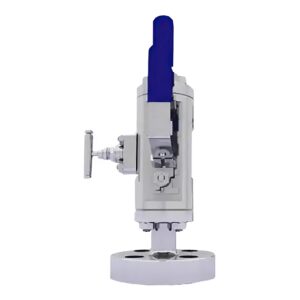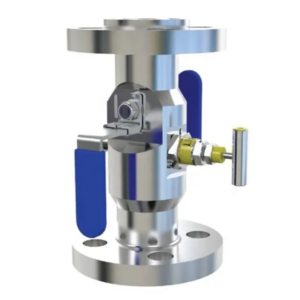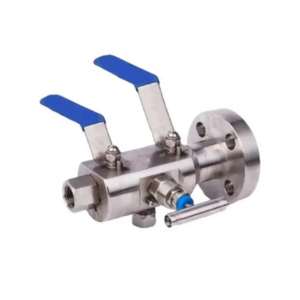Introduction of DBB Valves
Double Block and Bleed (DBB) Valves are critical in industrial processes. They combine two isolation valves and one bleed valve. This integration offers a streamlined fluid-handling solution. DBB valves are essential for applications like chemical injection and pig signaling. They ensure safe isolation, cut costs, and resist vibration-induced problems. Industries ranging from oil and gas to pharmaceuticals rely on DBB Valves for safety and efficiency.
مولفه های
| نام | Double Block and Bleed Valve |
| مواد | 304 SS or 316 SS |
| دمای عملیاتی | 54 – 640°C |
| ویژگی | 1. Easy to operate |
| 2. Cost-effectiveness and versatility | |
| 3. Long life and high efficiency | |
| پرداخت | TT/FC |
| مزایای | 1. The reduction in installation and component costs can result in cost savings of up to 70%. |
| 2. Good sealing | |
| 3. Minimized vulnerability to issues stemming from vibrations |
DBB Valves Mechanics Summary
A. Isolation Valves’ Role
Two isolation valves in a DBB valve act as a strong barrier. They sit around the bleed valve and stop fluid flow. This double block is great for safely shutting off fluid during repairs.
B. Bleed Valve’s Function
The bleed valve is between the isolation valves. It lets out any fluid caught between them. This makes it safe to open the pipeline for work without fluid pressure risks.
C. Isolation and Bleeding Steps
To isolate with a DBB valve, close both isolation valves, then open the bleed valve to release trapped fluid. This makes the area safe for work. Close the bleed valve and open the isolation valves to restart fluid flow after finishing.
Comparisons and Considerations of DBB Valve
Comparing DBB Valves with Traditional Valve Systems
DBB valves have many advantages over traditional valve systems. Unlike traditional systems that need two or more valves for isolation and bleeding, a DBB valve can make it. Besides this advantage, they are more compact, efficient, and cost-effective. The DBB valve also provides a higher level of safety through its double block function, ensuring complete isolation of the process fluid.
In comparison, a DIB valve, which is similar to a DBB valve, provides double isolation. It means that it can seal off the process flow from both directions. This makes DIB valves especially useful in systems where you need to ensure that no fluid can pass through from either side.
Factors to Consider When Selecting DBB Valves
When choosing DBB valves, there are several factors to consider.
Material compatibility: Analyze the compatibility of valve materials and process media. Some media may require valves made of materials resistant to corrosion or degradation by chemical interactions.
Operating conditions: Confirm that the pressure and temperature resistance of the valve are in line with the environmental conditions it will face. The valve must be able to work reliably within the operating parameters of the system.
Size requirements: Make sure the valve size is consistent with your pipe specifications. Choosing a DBB valve with the right diameter is critical for proper integration into the system.
Financial impact: Balance the upfront investment with potential cost savings during the valve’s life. While the initial cost of DBB valves can be high, their long-term benefits are also an important consideration.
Differences Between DBB And DIB Valves
DBB valves are a good choice when you need to make sure no liquid passes through the maintenance system. There are two valves in it. They are like a stopper. There is a bleed in the middle to deal with any liquid between them. When you close both valves, they will be sure no liquids will pass. The DBB valve is the one you need in your system. DBB valves have a double-blocking system. It has a dedicated bleed valve to improve safety during maintenance operations. The DBB valve consists of two separate valve groups. The cavity between the two can be drained or vented. When the two isolation valves are closed, no fluid can pass through the valves. It is a good choice for system maintenance. The bleed valve has a safety function. It ensures that any residual pressure or fluid between the two valves can be safely removed. This makes the DBB valve particularly useful in preventing any leakage or fluid mixing.
DIB valves provide double isolation in different ways. The DIB valve has two isolation functions. One is to isolate the upstream pressure, and the other is to isolate the downstream pressure. Each isolation valve in the DIB valve has an isolation function. The two sides of the DIB valve can be pressurized independently of each other. DIB valves have sealing capabilities. For example, a DIB valve prevents the upstream fluid of the valve from mixing with another fluid downstream.
Although DBB and DIB valves look similar, there are differences between them. They are suitable for different applications. Therefore, it is necessary to understand these differences to choose the right valve for your specific needs.







هنوز هیچ بررسی وجود ندارد.